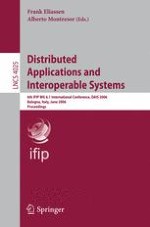This volume contains the proceedings of the IFIP WG 6.1 International Working Conference on Distributed Applications and Interoperable Systems VI held in Bologna, Italy, on June 14-16, 2006. The conference program presents the state of the art in research on d- tributed and interoperable systems. In recent years, distributed applications have indeed gained a practical and widely-known footing in everyday computing. Use of new communication technologies have brought up divergent application areas, including mobile computing, inter-enterprise collaborations, and ubiquitous s- vices, just to name a few. New challenges include the need for service-oriented - chitectures, autonomous and self-managing systems, peer-to-peer systems, grid computing, sensor networks, semantic enhancements, and adaptivity and - namism of distribution constellations. Following the evolution of the ?eld, DAIS 2006 focuses on architectures, m- els, technologies and platforms for interoperable, scalable and adaptable systems that are related to the latest trends towards service orientation and self-* pr- erties. The papers presented at DAIS 2006 cover methodological aspects, tools and language of building adaptable distributed and interoperable services, fault tolerance and dependability, peer-to-peer systems, mobility issues, web services applications and performance issues and composition, semantic web and sem- tic integration, and context- and location-aware applications. Also included in these proceedings is an invited paper by Jan Bosch and colleagues (Nokia - search Center, Finland) addressing the apparent con?ict between usability and the architectural drivers that drive success or failure of mobile services.
